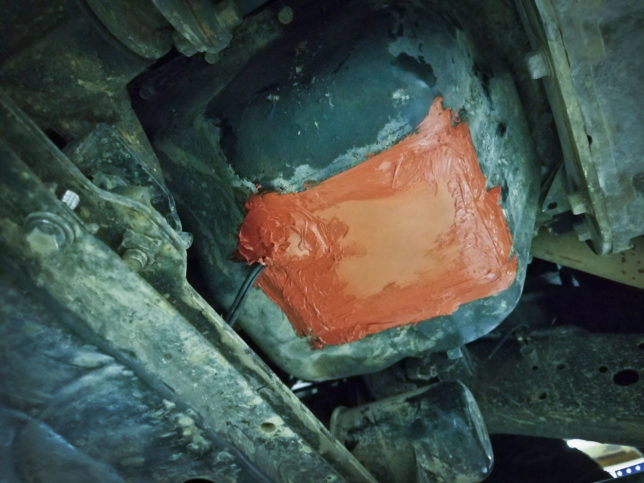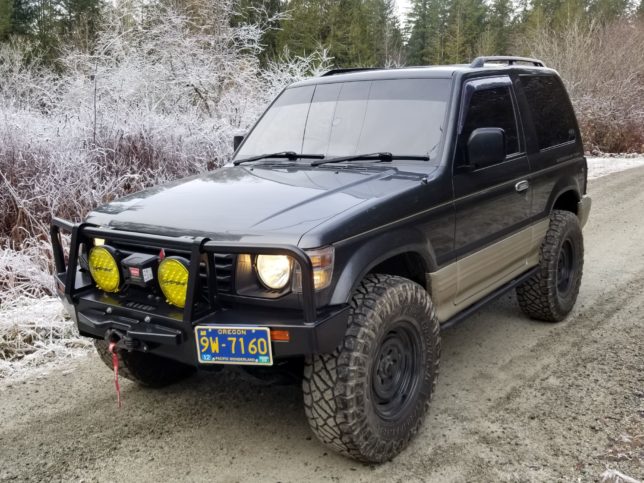In less than two weeks, we’ll be departing for the 2020 Alcan 5000 Winter Rally. Frankly, I don’t know if we’ve ever prepared for anything this much. The vast majority of the prepping has revolved around getting the rig ready for temperatures that could dip below -30° F. As I type this—ironically from Palm Springs International Airport where it’s 71° F—it’s currently -19° F in Inuvik, Northern Territories and forecasted lows are supposed to be -31° F. Oh, and this is all before any windchill is factored in. Needless to say, there’s a fair bit of cold weather vehicle preparation to do to our Pajero.
Mercedes and I hail from the Midwestern plains, where wintertime temps can dip well below zero, so we know how to dress for it. But getting a car ready for such arctic conditions requires preparation, no matter where you live, and even more so if you’re driving and old diesel-powered vehicle like we are.
Our ’91 Mitsubishi Pajero (aka the Terra Tractor) features a 2.5-liter turbo-diesel powerplant. And as many gearheads know, diesel-powered vehicles require extra attention when it comes to freezing temps. Here are some of the things we’ve done and are doing to our old diesel to ensure reliable starts and travels during this event. These are essentially cold weather vehicle preparation tips that can be used by anyone.
Optima REDTOP Batteries

You can do everything in your power to make sure your rig is ready for freezing temps, but if you can’t get enough juice to get it to crank over, it’s all for not. We looked for batteries with high cold-cranking amps (CCA), a rating designate for cold-weather performance. We have previously used Optima batteries in our Jeep Cherokee and Suzuki Sidekick, so we turned to them again for this vehicle. Our Pajero came with a factory dual battery setup, so we needed two batteries with as many CCA as we could get. While their YELLOWTOP units are designed to be used for vehicles with multiple accessories, such as winches, lights, comms, etc., their REDTOP batteries had more CCA, so we opted for two of them. Our diesel engine uses glow plugs to warm the cylinder chambers and they use a lot of juice, so having powerful batteries is even more important. Optima has never let us down in the past, and we don’t anticipate any issues this time either.
Webasto Thermo Top Evo Coolant Heater

Diesel engines generally don’t like cold, and one thing we’re going to try to do is keep this mill warm, even when we’re not driving it. A major part of that system will be the Webasto Thermo Top Evo coolant heater. This unit, about half the size of a shoe box, circulates the engine’s coolant while heating it with diesel from the vehicle’s tank. This not only keeps things warm in cold temps when parked, but will also provide instant warm air for the cabin.
This is how it works: Diesel fuel is pumped from our auxiliary fuel tank to the Thermo Top Evo. It is ignited using a glow plug. Simultaneously, the unit pumps engine coolant past the heater warming it all up. Exhaust is run under the vehicle. The amp draw is very low, and fuel consumption is also minimal. The system includes a timer than can be programmed to automatically turn on hours or minutes before we leave helping to ensure an easier start. We’ve tested the unit several times and it’s quite slick.
The unit was expertly installed at EarthCruiser in Bend, Oregon and will likely be a vital component of starting our old diesel engine in The Arctic. While this is an extreme cold weather vehicle preparation thing, where we’re going is equally extreme.
Oil Pan Heater

I’ve been told that fluids do “weird things” in extreme cold. Engine oil is the lifeblood of a car, and ensuring proper lubrication is essential. We purchased a 150W oil pan heater which adheres directly to the oil pan warming it like a miniature electric blanket. These pads come in various watts and sizes for a variety of applications. I measured ours out and used the recommended formula of 15–30 watts per liter of oil to choose its power rating.
To install, I removed a section of paint from the pan, sanded it down, then peeled back the adhesive backing from the pad. I sealed the edges using high-temperature gasket maker to prohibit water and debris from getting under it. I then carefully routed the cord to the vehicle’s front so it could be plugged in. Speaking of, we purchased a cold-weather extension cord that’s good to -58° F so our oil should be nice and warm.
Lower Viscosity Oil

Generally, I run a 15W40 motor oil in the 4D56 engine. However, for a colder climate, we decided to go a bit thinner.
Mitsubishi’s factory service manual recommends owners in cold areas go down to a 5W40 motor oil for better lubrication when cold. In addition, we opted to go full synthetic. I bought Valvoline Premium Blue oil. Valvoline is a well-known name in oils and I trust the product’s years’ long reputation for quality lubricants. When filling the engine with the 5W40 on a cold January evening, I could immediately tell the oil was thinner.
Other Miscellaneous Measures
A few other cold weather vehicle preparation tips we did to ensure success in the ensuing sub-zero temperatures included:
- Testing the coolant. I bought a coolant tester to see how cold our coolant will get before freezing. It turns out our coolant should be good to -29° F. While we may see temps lower than this, our coolant heater should help combat any issues. Regardless, knowing where you stand on this is a good thing.
- Cleaning power window tracks. The power windows on the Terra Tractor were a bit slow. In fact, on colder days in Portland (e.g. 40° F and below), the passenger’s side window wouldn’t roll back up. I cleaned the tracks and lubricated them using silicone spray. This entailed popping the door panels off, pulling the plastic back and getting at all the rubber. I also lubricated the cable and center track (the track got lithium grease). Afterward, it was a night-and-day difference.
- Three-peak-rated tires. We opted for a set of Nitto Exo Grappler tires and added studs to them. These tires feature the three-peak mountain snowflake emblem meaning they’re better in snow than a typical tire. While this does not make them a dedicated winter tire, it does provide an advantage over tires without the designate. FYI, a snow tire or three-peak-rated tire is required for participation in the Alcan 5000 Winter Rally.
- Winter Wipers. Seeing is, you know, kind of important. We swapped out our standard wiper blades for a set of winter-specific ones. These winter blades often feature rubber made from a different compound allowing the blades to work better in cold conditions. Plus, parts of the blades are often one piece or covered in coating to help prohibit ice buildup.
- Diesel Additives. North of Seattle we’ll run into winterized diesel fuels. This means the fuel will be fortified with additives to help prevent the fuel from gelling—one of the biggest issues with cold temps and diesel fuel. However, we’ll be bringing a few bottles of diesel additives to help in case things still gel up.

Andy Lilienthal is an award-winning writer and has written professionally since 1999. He has over 13 years in the automotive aftermarket working at companies including Warn Industries, Bushwacker, and Lund International. Editorial works include writing and photography for off-road print magazines, to new-car reviews online. He’s a photographer with images in multiple magazines, blog sites, and The New York Times.


Leave a Reply